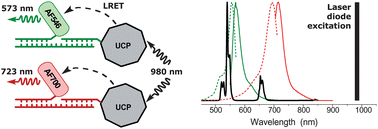Upconverting phosphors in a dual-parameter LRET-based hybridization assay†
Abstract
Upconverting phosphors (UCPs) are lanthanide-doped sub-micrometer-sized particles, which produce multiple narrow and well-separated anti-Stokes emission bands at visible wavelengths under infrared excitation (980 nm). The advantageous features of UCPs were utilized to construct a dual-parameter, homogeneous sandwich hybridization assay based on a UCP donor and lanthanide


 Please wait while we load your content...
Please wait while we load your content...